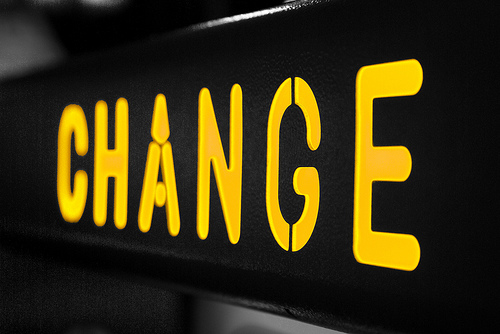What Hasn't Changed

Our society is addicted to the idea of progress. We're prone to think technological change fundamentally alters the way we do things. In reality, the fundamentals tend to endure through the ebb and flow of technological adoption.
Zappos isn't the first company to provide stellar service, and the conversations that take place on Yelp used to take place around the water cooler. As marketers, we can sometimes learn more by analyzing what hasn't changed rather than what has. There's a lot of talk about tactics and tools these days, but lets get back to fundamentals. Strategy is king.
picture from http://www.flickr.com/photos/spursfan_ace/2328879637/
The Hidden Cost of Charging for Luggage
About a year ago Delta Airlines made a decision to start charging for luggage. The plan was simple. $15/bag for suitcases under 50 lbs and a $90 surcharge for bags over 50 lbs. Delta ran the numbers and figured out it would be an easy way to drive additional revenue. Their research probably showed that the only thing people really care about is the price of the ticket, and it was probably further rationalized by the fact most trips are short enough that a carry-on bag can suffice. Charging for bags would make flights more profitable, but it would also have consequences.
The biggest consequence of this decision was expected. Delta knew customers would be upset when they had to pay $15 for baggage, so I'm not going to focus on that. What's more interesting are the consequences they didn't plan for.
A $90 surcharge on bags over 50 lbs is an extremely large fee. It's potentially a 1/3 or more of the total ticket price. Naturally people will want to avoid this fee. However, the 50 lbs mark is right at the upper limit of what a large bag would weigh, so a large number of customers will carry bags that are 51-55 lbs (especially for couples who share a single bag), and the majority of customers who encounter this fee will be barely over the "limit." These customers will try to do anything to avoid a fee of this magnitude. In fact, many customers start to unpack their luggage while it's sitting on the scale in order to try and get below the arbitrary 50 lbs limit.
The question now becomes, how much longer does delta spend interacting with each of these angry customers unpacking their bags at the check-in counter to avoid the $90 fee? A normal bag drop-off takes a minute, maybe two minutes. Each customer who unpacks their bag at drop-off to avoid the fee will generally take 7-10 minutes. One customer now takes the same amount of time to deal with as 3 used to. This an efficiency cost, and it won't be offset since the overweight baggage fee goes uncollected.
The other unintended consequence of this decision is that it encourages people to use larger carry-on bags. This means more bags must now fit in the carry-on compartments. Boarding is no longer about getting people to their seats, it's about finding space for all the carry-ons. Instead of preparing for take-off, flight attendants spend 10-15 minutes moving and re-packing carry-on compartments.
It's not that Delta doesn't understand behavioral economics, they do. And, it's not that they didn't carefully study this decisions, they did. They just failed to account for the unintended consequences. They were so focused on the potential increase in top line revenue that they ignored the hidden costs associated with it.
The Setting For Good Stories and Brands

Just like novels, the story of every successful brand has a setting. There's a specific time and a unique set of circumstances that allows the brand to become a leader in their industry. Whether that's the creation of a new market, or the dismantling of an old one. Successful brands take full advantage of the opportunities that are presented to them.
What is important about the setting isn't dates or geography, it's the events and circumstances that influence the main characters, or for the sake of our analogy, the brand. For example, on January 11, 1949, in Pittsburgh, Pennsylvania, KDKA-TV went live as the only local on-air television station in Pittsburgh. But, the most important factor of this setting wasn't the time or place, but the fact that KDKA-TV was one of the last television stations to be given construction rights by the FCC before a four year freeze on new licenses.
The Declining Scarcity of Knowledge

Scarcity breeds value. As scarcity decreases, so does value.
For example, traditional boards for the game Go (these boards are called gobans; to learn more about the ancient Chinese strategy game click here) are made from the wood of the rare Kaya tree. You can make a goban out of just about any type of wood, but several features make the wood of the Kaya tree particularly desirable: "beautiful yellow-gold color, fine and uniform ring texture, and the sonic quality of the click of a stone on its surface." Here's the catch: harvesting Kaya trees alive is illegal, and they have to grow several hundred years to reach the width required to craft a goban. Good luck waiting hundreds of years for a tree to die. It doesn't get much scarcer than that, and these pieces of wood are priced accordingly: traditional goban cost upwards of $20,000. (That's about three years at the average four year university.)
On the other end of the scarcity spectrum are social media "gurus". While these experts are particularly vulnerable to critique, it's not surprising that there is a scramble of self-proclaimed experts coming out of the woodwork -- social media is cheap to learn, and information about the industry is ubiquitous. However, these experts are only the prelude to the real effects of wide spread, free knowledge. In a world with fewer and fewer barriers to information, there are more and more experts. Consequently, because it is no longer scarce, knowledge is becoming less valuable. It's a commodity.
The real value then, is in things that are still rare: character, hard work, and the ability to learn quickly.
sources:
TD Gammon—the most amazing computer you've never heard of.
The only way to improve is to focus on what you're doing wrong. This simple concept turned an unassuming computer program into the most dominant backgammon player in history. The computer was called TD Gammon, and it changed the way we think about the world.
Gerald Tesauro created TD Gammon in 1992 to test his theories on artificial intelligence. The goal was to make TD Gammon the best backgammon player in the world. In the beginning, TD Gammon picked each move randomly. It wasn't programmed with good moves, or bad moves.
Unlike Deep Blue, the famous chess playing computer who predicted millions of moves in advance, it didn't rely on the brute force of predictive logic, it simply measured its rate of failure. In fact, TD Gammon could only search 3 moves in advance during it's 15 second turn. TD Gammon could only improve by practicing its craft. Each move it made was recorded and the outcome logged. If it lost a game, it focused on identifying the moves that caused it to lose. TD Gammon analyzed only its short comings, the errors that it made, and how to resolve them.
Over time, TD Gammon improved to an astounding degree. Within a few years it was the world's best backgammon player. Kit Woolsley, a previous backgammon champion, said "There is no question in my mind that its positional judgment is far better than mine."
TD Gammon could care less about success. It had no ego. It didn't care if it made a brilliant move, or how many games it actually won. It only cared about the errors it made. It was programmed to do nothing, but continually improve. And that single-minded focus allowed it to dominate its field.
Experimental Media Intakes
Experimenting is a part of working in the online space. The media, search, and social landscapes are constantly in flux. Standards come and go, and the daily feed of information is closer to real time than it ever has been. To be any good at interactive marketing you have to experiment. You have to question the assumptions about the way search engine's function, the way information can be taken in, and the value of various marketing tactics.
One of the ways I choose to experiment is by periodically changing how I keep up with information online. There have always been a few staple blogs that I read to keep up with discussions about particular niches, but for the most part I keep my media diet in a changing state to keep up with the media's own rapid rate of fluctuation. Sometimes I'm subscribed to hundreds of blogs; sometimes I'm subscribed to five. Sometimes all I do is scan Twitter and other times all I do is Tumble. Most of the time I mix and match, and I think that's probably true for most people whose work relates to online media.
PSFK made an interesting comment in a post recently that they are trying to become The Economist of ideas -- not only with their blog, but with their Twitter feed. One reader said that they hardly read anything now besides the PSFK Twitter feed which links to more than just what gets posted on PSFK. I'm considering trying this out for awhile. I think it will be an interesting test not only of PSFK's trends coverage, but also of Twitter as an information source. I've never subscribed to a twitter feed via RSS before so I'm looking forward to seeing what it's like.
What do you think? What's your favorite way to keep up with information online? What platforms are your favorite and how do you experiment?
p.s. Google Reader is coming up strong with the like/share options.